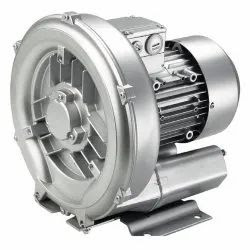Positive Displacement Blowers
Positive Displacement Blowers (PD Blowers) are a type of air-moving device used to deliver a fixed volume of air or gas per revolution of the blower, regardless of changes in system pressure. They are widely used in various industrial applications due to their efficiency and reliability.
Key Features of Positive Displacement Blowers
**1. **Operation Principle
- Fixed Volume Delivery: They move a specific volume of air with each rotation, which means the flow rate remains constant as long as the speed is unchanged.
- Displacement Mechanism: The air is displaced by the rotating lobes or pistons, creating positive pressure.
**2. Types of Positive Displacement Blowers
- Roots Blowers: Feature two counter-rotating lobes that trap and move air. Commonly used for applications requiring high volume and moderate pressure.
- Vane Blowers: Utilize a rotating vane within a chamber to move air. Suitable for applications needing precise flow control and low to medium pressure.
- Screw Blowers: Employ two interlocking screws to compress and move air. Known for their smooth operation and energy efficiency.
**3. Applications
- Industrial Processes: Used in processes that require consistent air flow, such as pneumatic conveying, material handling, and wastewater treatment.
- Aquaculture: Provides aeration for fish tanks and aquaculture systems.
- HVAC Systems: Utilized for ventilation and air circulation in heating, ventilation, and air conditioning systems.
**4. Advantages
- Consistent Flow: Delivers a steady volume of air regardless of pressure changes, ensuring reliable performance.
- High Efficiency: Generally efficient in converting power to air movement, with relatively low energy consumption compared to other blower types.
- Durability: Built to handle demanding environments and high operational pressures.
**5. Maintenance and Operation
- Routine Checks: Regular inspection of moving parts, lubrication, and checking for leaks or wear.
- Proper Installation: Ensuring correct alignment and installation to prevent damage and ensure efficient operation.
- Filter Maintenance: Keeping air filters clean to avoid clogging and maintain optimal performance.
Choosing a Positive Displacement Blower
- Flow Rate Requirements: Determine the required flow rate and pressure to select the appropriate size and type of blower.
- Application Needs: Consider the specific requirements of your application, including operating environment and required efficiency.
- Manufacturer and Support: Choose a reputable manufacturer with good support and service options.
If you need more detailed information or have specific questions about positive displacement blowers, feel free to ask!
Straight Bi Lobe Technology
Straight Tri Lobe Technology
Twisted Tri Lobe Technology
Helical Screw Technology
Blower Packages
Straight Bi Lobe Technology
Straight Tri Lobe Technology
Twisted Tri Lobe Technology
Helical Screw Technology
Blower Packages
Positive displacement blowers, oftentimes called “PD blowers”, are utilized to move air through a wide variety of industrial applications such as chemical, agriculture, bulk transport and more.
The selection of positive displacement blowers built by Gardner Denver is second to none and includes:
Straight bi-lobe blowers
Straight tri-lobe blowers
Twisted tri-lobe blowers
Helical screw blowers
Blower packages
No matter if your job calls for individual blowers or blower packages, Gardner Denver has the technology you need. From our legendary Sutorbilt name to the rugged and reliable Duroflow and all the way up to the superior Cycloblower, Gardner Denver has the best positive displacement blower selection and technology in the industry.
Common Types of Positive Displacement Blowers
The different types of positive displacement blowers may differ in their construction or operation but all are designed to assist with the movement of materials. PD blowers simply trap and then discharge air to propel materials through pipe or hose which makes bulk transport a quicker and more efficient operation.
Straight Bi-Lobe Blowers – employ two figure eight rotors (or lobes) that rotate
Straight Tri-Lobe Blowers – utilizes straight rotors with three lobe design, less noisy and lower pulsation compared to bi-lobe
Twisted Tri-Lobe Blowers – has helical tri-lobe rotors, smoother pulse operation to extend the life of the bearings
Helical Screw Blowers – helical rotors with unique screw design for superior energy savings
Blower Packages – Plug and play simplifies installation and enclosures cuts down on noise levels
Description of Positive Displacement Blower Operation
Positive displacement blowers discharge air out into a pipe or hose in order to move materials. Rotors revolve and air is pulled into the inlet port, air is forced into tight areas between the rotors and casing then is forced to the outlet pipe (or hose). The term “positive displacement” comes from the fact that the volume of air doesn’t change within the blower but is displaced from one end to the other during operation.
Some of the most common industries that utilize positive displacement blowers include:
Aquaculture
Chemical
Dairy
Cement
Oil & Gas
Pulp & Paper
Power Generation
Dry Bulk
Milling
Plastics
Wastewater Treatment
Environmental
blowers_news-section
Latest News
Cycloblower
Join us as we introduce an extraordinary transformation in the world of industrial equipment! Gardner Denver, acclaimed for its reputation for excellence and innovation, proudly introduces its latest breakthrough: the 125CDL CycloBlower H.E. Explore the groundbreaking features of this r
